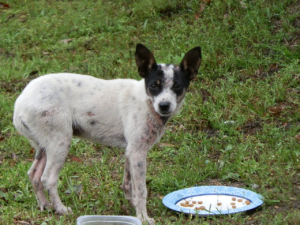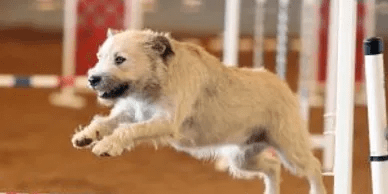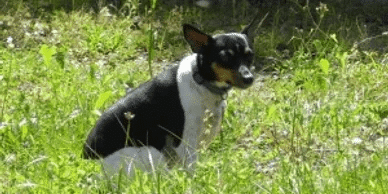 Ahhh, Springtime! Flower time, shower time … stray dog-and-cat time. Yep, it’s puppy-and-kitten season, which also means dumped-animal season. Tossed out like garbage, these baby animals sleep under cars in parking lots, hide out in culverts, and scrabble for sustenance wherever they can find it. Dumped animals need our help, but they’ll be afraid to accept it.
Ahhh, Springtime! Flower time, shower time … stray dog-and-cat time. Yep, it’s puppy-and-kitten season, which also means dumped-animal season. Tossed out like garbage, these baby animals sleep under cars in parking lots, hide out in culverts, and scrabble for sustenance wherever they can find it. Dumped animals need our help, but they’ll be afraid to accept it.
You (or someone you know) may come across a stray in need of rescue, so I thought it would be helpful to share some tips on how to convince frightened, abandoned animals to accept assistance. And since my friends Celia and Joel recently managed to rescue a reluctant stray puppy, I’ll start with their story.
My friends noticed a puppy living in a culvert. They’ve been feeding her, but until recently, hadn’t been able to get close enough to touch her. Celia knows how to communicate with animals, but after a few weeks of trying to convince the dog to come with them, she asked for my help. She sent me a picture of the dog (they named her Cookie) so I could try to communicate and send energy healing to help Cookie release her fears and trust humans again.
Cookie wouldn’t “talk” to me—which is not uncommon with abandoned strays—except to let me know that she’s been on her own for what seems like forever and can hardly remember her life before abandonment. She didn’t want to share anything about how she came to be living in a culvert.
Cookie didn’t want to talk, but she was willing to listen. She allowed me to show her what it would be like to trust Celia and Joel to help her. I did energy healing to help Cookie release some of her trauma so she could think straight and see that my friends are trustworthy and won’t harm her.
The morning after I did the first round of energy healing, Cookie wagged her tail for the first time. (Before, it had stayed pinned between her legs, a self-protective posture.) Progress was made. The second day, Cookie came close enough to eat food they held out to her. The third day, she let them touch her.
Celia and Joel were patient, courting Cookie for weeks while she made up her mind. But her desire to trust was eclipsed by her fear. She couldn’t bring herself to get in the truck with them, but she started chasing their truck whenever they left.
Joel knew that Cookie’s new habit put her in danger of getting hit by a car, so on their next visit to the culvert, he made a calculated risk and grabbed Cookie while Celia was petting her. The move took both Cookie and Celia by surprise. Cookie bit his hand, but he was prepared, and he didn’t let go. They hustled her to the truck and took her home, and only a day later, she is settling in well, napping on the bed with her new people and playing with their other dogs.
I don’t advocate getting yourself bitten by a stray dog. Joel did it, and I’ve done it, but we’re professional dog people (and possibly just a little bit crazy). Grabbing a dog you don’t know is a last resort (AKA bad idea) and even then, I wouldn’t grab a grown dog or cat. Every situation is different, and you’ll have to use your intuition and judgment on how to proceed.
In emergency situations (especially involving very young puppies or kittens) I’ve opted to catch them right away. Once, I enlisted help (my kids) and followed an entire litter of puppies into the woods, hunted them down one by one, and dragged them out from under rotten logs. (Tessa got bitten, but it didn’t break the skin, and she didn’t let go.) We didn’t like having to do it, and neither did the puppies, but we all went to sleep that night knowing that those puppies would all be alive the next morning.
Here’s what you’ll need to know if you want to help a stray animal this puppy-and-kitten season:
- They’ll be afraid to be picked up because the last time a human picked them up, they got tossed out an open car window or door.
- Afraid to be touched, because the last human that touched them betrayed them in the worst way.
- Afraid to eat food that’s offered, because they fell for the lure of food only to be snatched up when they were eating, taken away from their home, and abandoned in a strange place.
- Afraid of loud noises, thunder, rain, lightning, fireworks, guns, because they’ve felt the fear of hunkering down all alone while it seemed that the world was crashing down around them.
- Afraid of humans—who they’ve learned can’t be trusted—and of other animals, who’ve chased them away from already-claimed territory, or worse, attacked them when they couldn’t run fast enough or find a good-enough place to hide.
- They’re amped up on adrenaline, their fight-or-flight mechanism on overdrive, so full of fear that they can’t think straight. It’s no wonder they won’t come to you. They want to, but it’s just too scary.
Best case scenario is when you can take the time to gain an animal’s trust, and that’s what I recommend whenever possible. It helps to keep the first few layers of Maslow’s hierarchy of needs in mind.
Step one: Physiological needs: Food, water, shelter. If you see a stray who won’t immediately come to you and accept your help, you’ll have to begin the process of earning their trust by bringing them food, water, and (if they don’t already have it) some form of shelter that you can put in a safe place near where you found them. You’ll need to come every day with fresh food and water, at about the same time(s), so they begin to expect and rely on you for sustenance.
Step two: Safety needs: You can’t help them feel safe until they trust you. To build trust, you have to go slow. In the beginning, when you first bring food and water, the animal may not feel safe enough to eat until you leave. Put the food down as close as you can get to their hiding place without causing them to bolt. Then back away, and if possible, find a place to sit so you won’t be perceived as towering above them. It will also help them to understand that you aren’t planning to chase them. If you’re sitting, they’ll understand that they have time to run if they need to. If, after a few minutes, they still refuse to eat while you’re there, leave them with the food and come back at the same time the next day. Once they will eat in your presence, begin moving a little closer every day, slowly increasing their tolerance to your proximity.
Step three: Love and belonging: This is where the magic happens. Every animal is different, but by now, you will have begun to form a bond and have a good idea of what kinds of interaction the animal will tolerate, and what actions you could take to help them come to you willingly. Here are some I’ve used:
Energy healing is miraculous and incredibly helpful. If you don’t do energy healing yourself, ask a friend, or pay someone to do healing for the animal to help them release their trauma.
Telepathy is easier than you think. Sit near the animal with your eyes closed, imagining what it would be like when they come to you, sit in your lap, allow themselves to be petted, picked up, and taken to a safe place where they’ll be cared for. Visualize it in detail every time you visit the animal. You can also do it when you’re not with them. Just imagine that you’re sitting near the animal and that they’re watching the scene when you visualize how happy and relieved everyone will be when they allows themselves to be helped.
Sing, hum, or play soft, soothing music for them.
Come bearing gifts: Treats, toys, blankets, an old shirt with your scent on it.
Some animals will be afraid to play, but playing may be the perfect bridge between you and the animal, especially if they’re very young, or if they’ve ever belonged to someone who played with them. Bring a ball you can roll past them and see if they’re interested. But be careful; if they think you’re trying to hit them with it, they’ll retreat, and you’ll have gone backwards in the relationship.
When you’ve been able to get close, but not quite close enough to touch, you can begin to use pack psychology on them. Alphas eat first, then share with the other pack members. Behaving like an Alpha inviting a new member to join the pack will help them feel safe. Bring a picnic lunch for yourself, and when you give them their food, sit nearby with your own (preferably delicious smelling) food. If they seem interested enough to watch you eat, toss them a few tidbits, then put the tidbits on the ground close to you. If they will come close to get the food, then see if they will take food from your hand. (This process may take several days, or it may happen in one sitting.)
If they will take food from your hand, you may be close to being able to touch and pet them. Be careful, though! Move very slowly and allow them to back away if they feel uncomfortable. When they willingly accept your touch, the next step is luring them onto your lap. Take your time. Go slow. Allow them to adjust to each new level of connection. (When I took our previously feral cat Glenn from the restaurant patio to our car, it took me at least ten minutes to walk to the car. I oozed across the parking lot, giving him time to relax after every step I took before I took another.)
I hope this will help you (or someone you know—feel free to share) save a life this puppy-kitten-stray season.











Thank you for sharing Cookie’s story. She has come so far in just two weeks. My appeal to your readers…. don’t turn away when you see these desperate creatures. Some are pitiful and hard to look at. But you may be their one and only chance. I learned this from Babette. We were returning home late one afternoon from shopping when she spotted an abandoned border collie. She never hesitated. We stopped the car and scooped him up. It took some manuevering and maybe even a little exaggeration about exactly where he was picked up, but we got him the care he needed.
Thank you for giving everyone these tips. We have dealt with strays and rescues of a variety of species many times over the years. Dogs especially like my husband and he can usually gain their trust in a short period of time. Sadly we can’t keep all the strays we have found but have kept our share. Our current dog appears to be a daschund-beagle mix. She isn’t very big and very skittish. She was found in the woods and was in good shape with trimmed nails and well fed. We contacted the animal shelter and Humane Society in two counties and posted on the local lost animal sites. No one reported her missing. The vet checked for a chip and she was spayed. We had the vet give her vaccinations and had her dewormed.
She is a sweet little thing, but the most skittish animal we have ever dealt with. She is about 2 years old and appears to be partially deaf. We got her last September and she still can’t relax. She likes being petted, but doesn’t relax into it. She still holds her tail up against her belly. Any shop or loud noise panics her. We told the vet and he didn’t realize how bad it was until the last visit. My husband dropped two credit cards on the floor and just that small a sharp sound had her panicking. The vet and the tech couldn’t believe it. She doesn’t know how to play and will not go off the porch is we try to take her for a walk. It is hard to imagine what her life was like before. I am sure another dog would help her realize she is a dog and how she can behave. Unfortunately now is not a good time for us to add another to the household. since we will be doing some traveling. We will keep speaking softly, giving her lots of love, and hope she feels more secure as time goes by. She is much better than when we got her, but there is a long way to go yet to be the happy little dog she should.
Congratulations on your move to Hawaii. It is always so much work to get ready for a move, but we always looked at it like an adventure. I hated to leave where we were but looked forward to what the new place had to offer. I hope the move goes well and the animals adjust to the disruption without too much trouble.